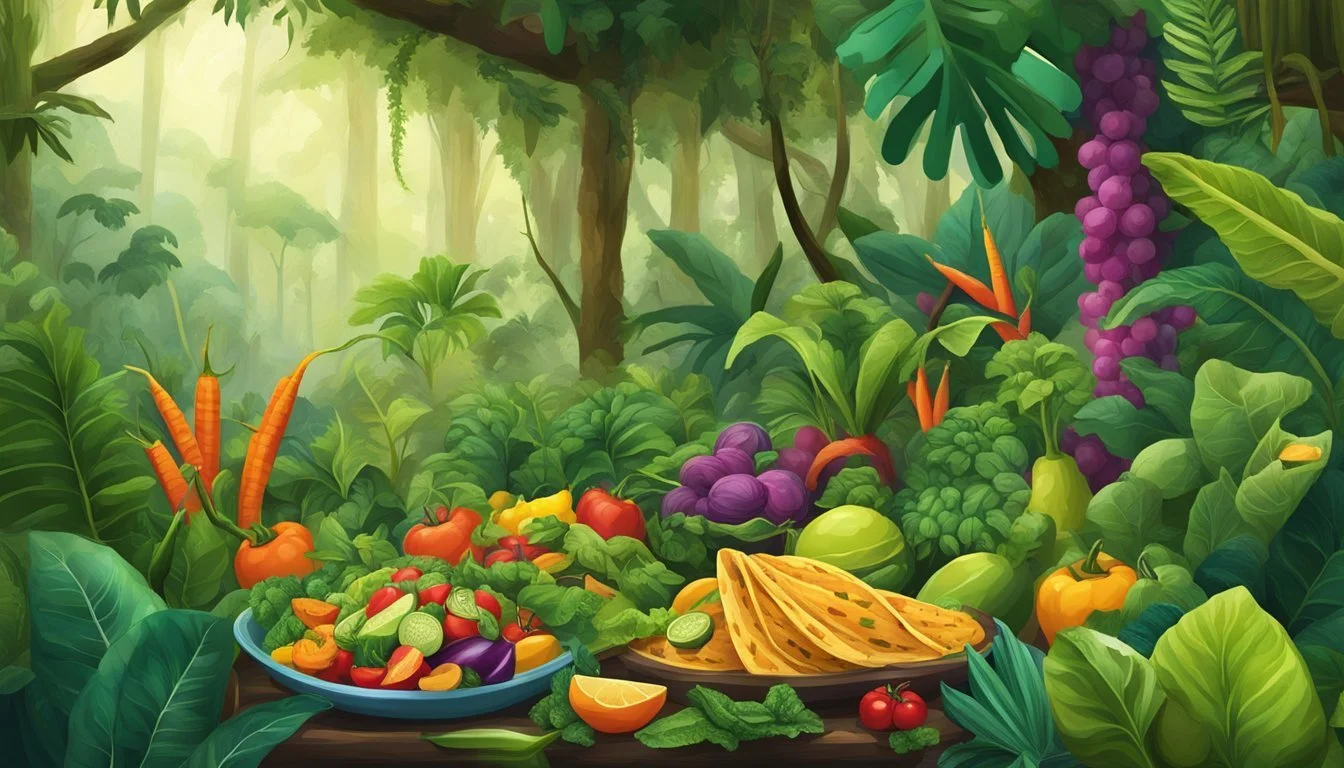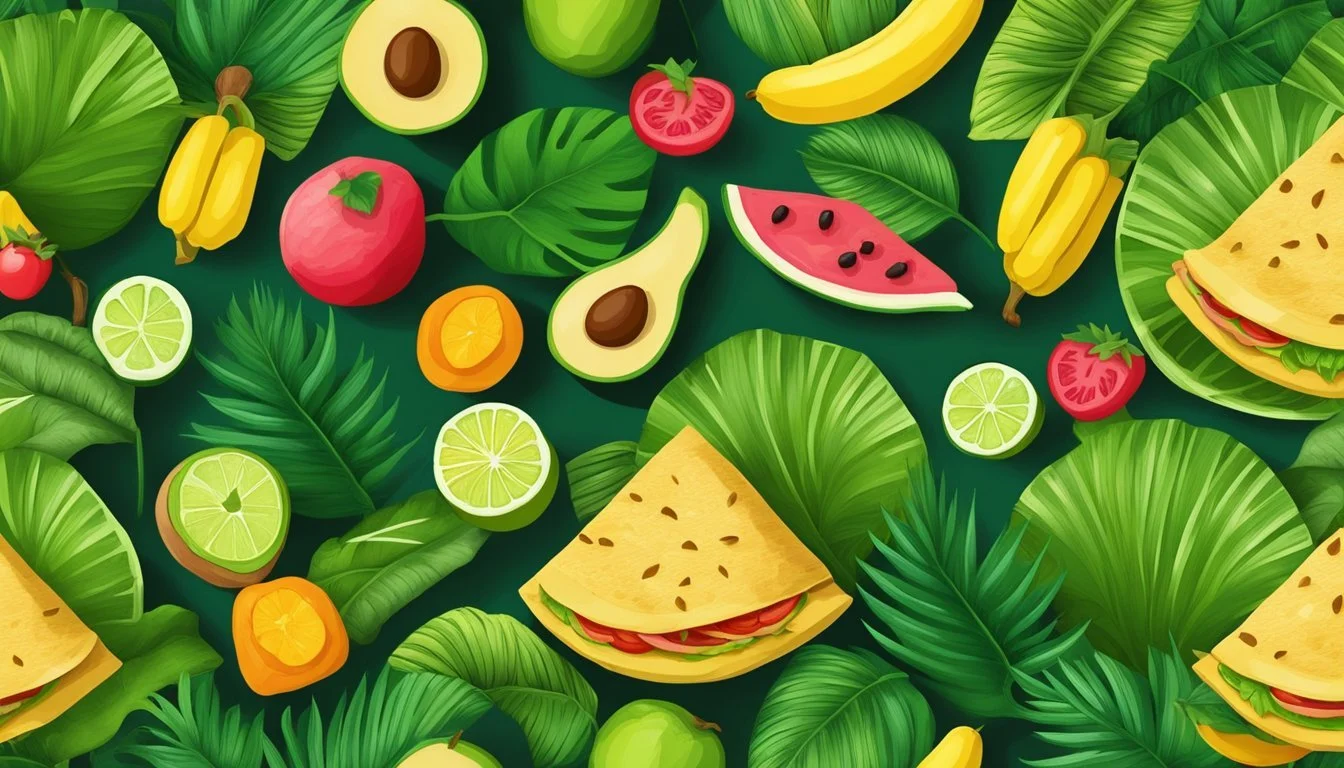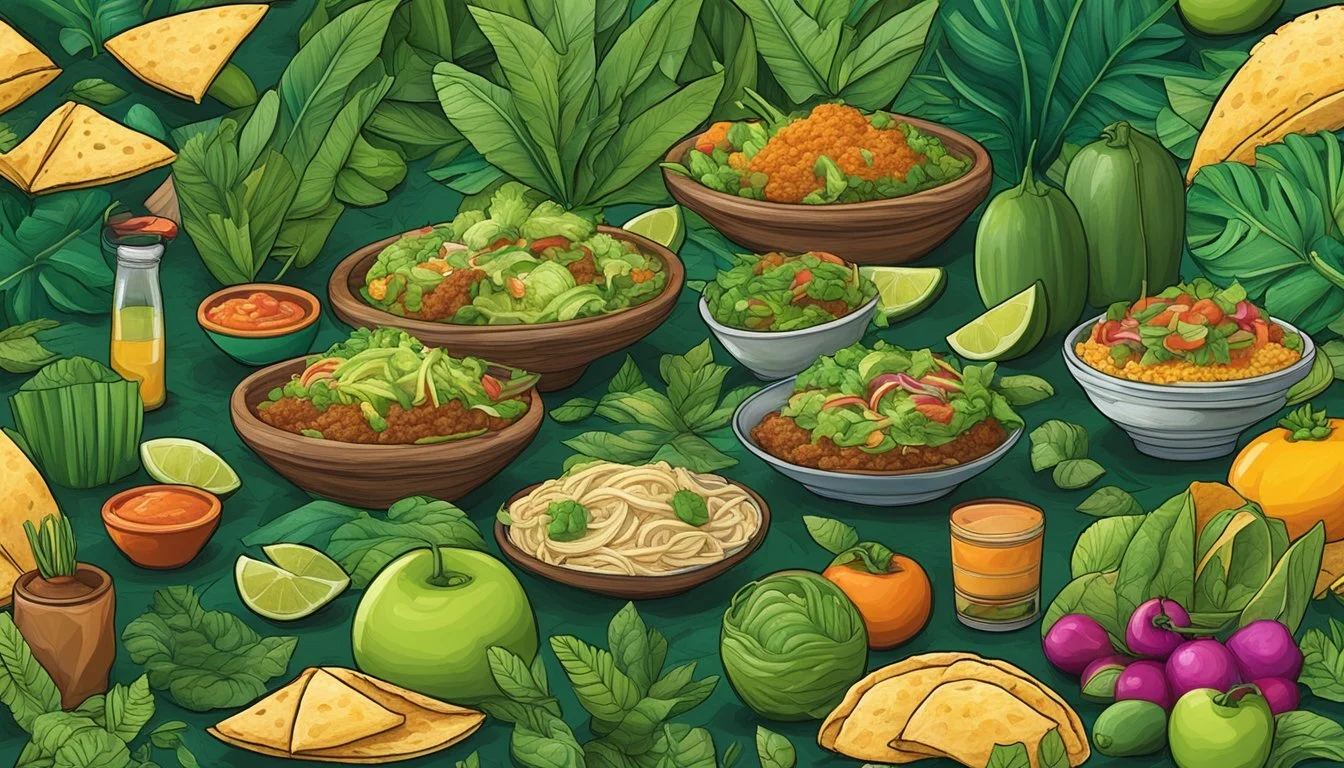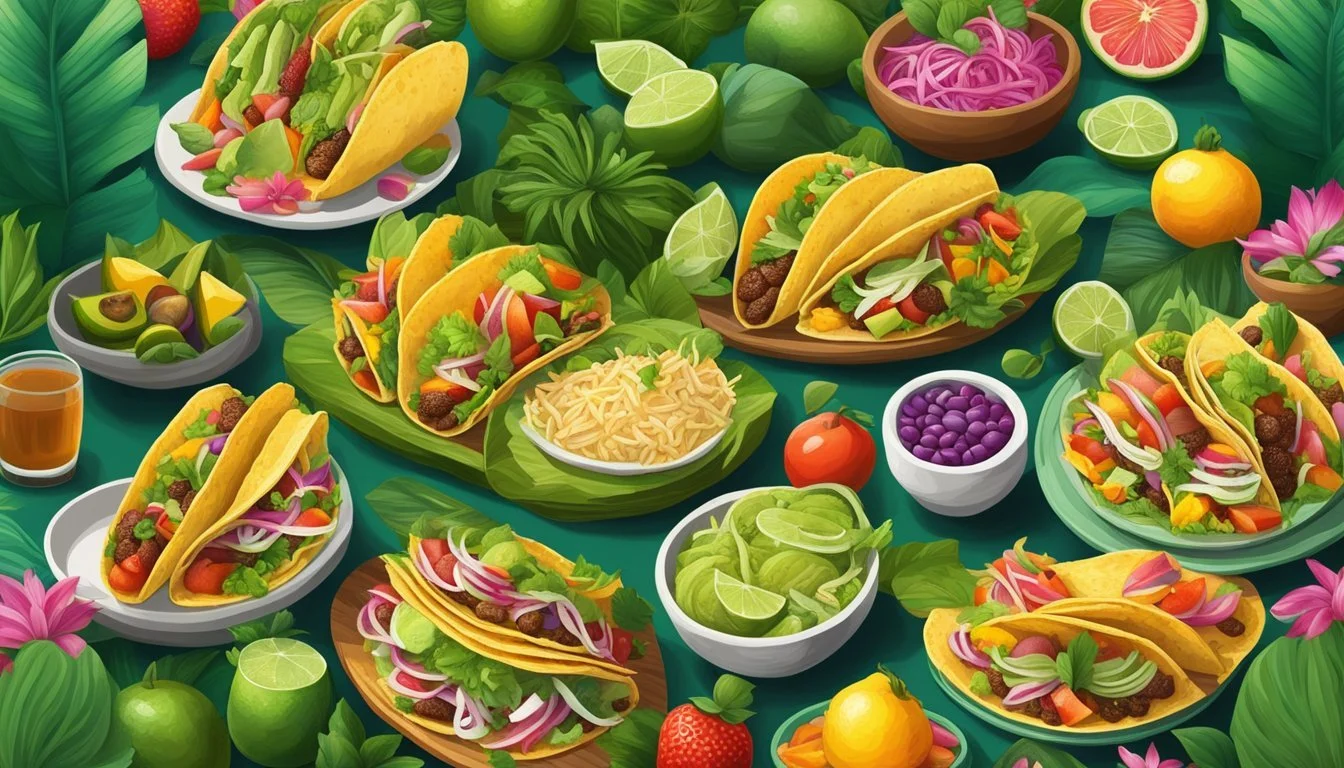The Tacos of the Mexican Rainforest
Exploring Culinary Secrets Amidst the Canopy
Tacos are a culinary tradition deeply rooted in Mexican culture, known for their rich and diverse flavors that capture the essence of the country's gastronomic heritage. Originating from the silver mines of Mexico in the 18th century, tacos have evolved from miner's sustenance to a beloved staple enjoyed across the globe. In the less explored regions of the Mexican rainforests, tacos are not only a dish but a narrative of the environment from which they hail, showcasing the local flora and fauna in each bite.
In the heart of the Mexican rainforest, traditional recipes are revered, and the making of tacos involves a symphony of fresh, locally-sourced ingredients. These recipes, shared from generation to generation, represent more than sustenance; they are a testament to the resilience and creativity of a culture that thrives in harmony with its surroundings. Mexican cuisine here is a reflection of the vibrant ecosystem, where the use of wild herbs, indigenous spices, and uniquely regional techniques offer a distinct twist on the classic taco.
The tacos from this lush backdrop stand apart from their urban counterparts, offering a taste experience that is as varied as the rainforest itself. They embody the spirit of Mexican culinary tradition, wherein each ingredient is selected with intention and care, serving not only to nourish but also to honor the land and its bounty. With flavors that span from the earthy and robust to the delicate and aromatic, these tacos offer a journey through Mexico's iconic culinary landscape, rich in history and alive with innovation.
The Rich History of Mexican Tacos
Exploring the depths of taco history reveals a rich blend of cultures, from the ancient Aztecs to the influence of Spanish conquests, shaping a culinary tradition that resonates with Mexico's culture and community identity to this day.
Pre-Hispanic Origins and the Aztecs
The tale of the taco begins long before European contact, rooted in the customs of indigenous people like the Aztecs. These ancient civilizations crafted a diet central to nahuatl beliefs and life, where masa, a dough derived from the nixtamalization process, played a crucial role. They fashioned this masa into various foods, similar to what we recognize today as the taco, that were both practical for eating and significant in ritualistic celebrations.
Spanish Conquests and Culinary Fusion
The Spain's conquest of the Aztec empire introduced new livestock, dairy, and spices, intertwining with the established culinary heritage. This fusion birthed unique flavors that gradually evolved into present-day tacos. Indigenous ingredients like corn and native spices melded with introduced foods like beef, pork, and cheese, creating an evolving culinary dialogue and a tangible representation of Mexican history on a plate.
Tacos in Modern Mexican Society
In contemporary Mexico, the taco is more than sustenance; it embodies the unity and sense of community that are pillars of Mexican culture. Street vendors and taco stands in bustling Mexico City and beyond are a testament to the evergreen popularity of tacos within societal norms and daily life, showcasing the adaptability and innovation that have always been inherent to this beloved dish.
Essential Elements of Tacos
In the world of Mexican cuisine, tacos stand as a testament to culinary creativity and diversity, with each element from tortilla to topping bringing a distinct dimension of flavor and texture.
The Role of Tortillas in Taco Creation
The tortilla, the foundation of any taco, must be chosen with intention. Traditional tacos use either corn or flour tortillas, each contributing its unique properties. Corn tortillas, often made via nixtamalization, provide a hearty and authentic taste, while flour tortillas offer a softer bite.
Variety and Versatility of Taco Fillings
Tacos are a mosaic of fillings, ranging from diverse meats like beef, pork, chicken, to seafood, and even vegetarian options like beans and vegetables. This rich variety ensures there's a taco to satisfy any palate, with the filling both reflecting regional biodiversity and the cook’s ingenuity.
Meats: Grilled, stewed, or slow-cooked options like carne asada, barbacoa.
Seafood: Fresh options including fish or shrimp, often seasoned or marinated.
Vegetables and Beans: Grilled corn, sautéed peppers, or refried beans for substantive alternatives.
Seasonings and Spices: Beyond Salt and Pepper
Tacos embrace an array of seasonings and spices that elevate simple ingredients to extraordinary heights. Essential spices such as cumin, oregano, cilantro, and garlic infuse fillings with depth and complexity. Whether it's the kick of onion and serrano chilies in a salsa or the earthy tones of oregano in a marinade, these seasonings are the soul of taco flavor.
Popular Taco Varieties
Exploring Mexican cuisine reveals a spectrum of flavors across various taco varieties. Key ingredients and regional cooking methods contribute to distinctive tastes characteristic of each type of taco, from the succulent marinades of meats to the tanginess of fresh toppings.
Tacos al Pastor: A Symphony of Tastes
Region: Central Mexico Key Ingredients: Marinated pork, pineapple, chili powder, red onion, cilantro, lime Flavor Profile: Sweet, spicy, and tangy
Tacos al Pastor boast a unique flavor blend that originated from Central Mexico. They feature thinly sliced, marinated pork that is traditionally cooked on a vertical spit. The pork is seasoned with chili powder and other spices, then crowned with a slice of pineapple, lending a sweet contrast to the savory meat. This delightful combination is then served on small corn tortillas and garnished with red onion, cilantro, and a squeeze of lime juice.
The Savor of Seafood: Fish Tacos
Region: Coastal Areas Key Ingredients: Fried or grilled fish, cabbage or lettuce, creamy sauce, lime juice Flavor Profile: Fresh, citrusy, crispy
Fish Tacos are a testament to the coastal regions' love affair with seafood. These tacos feature battered and fried or grilled fish as the star, nestled in a soft corn tortilla. Fresh vegetables such as shredded cabbage or lettuce accompany the fish, along with a drizzle of creamy sauce to complement the flavors. A generous splash of lime juice balances the dish with a bright, acidic finish.
Sizzling Carne Asada Tacos
Region: Nationwide Key Ingredients: Grilled beef, onion, cilantro, lime Flavor Profile: Rich, savory, smoky
Carne Asada Tacos are a ubiquitous presence in Mexican cuisine, relished across the country. The filling consists of tender slices of beef, typically skirt or flank steak, that's marinated and grilled to perfection. The meat's succulence is enhanced when served on a warm tortilla with chopped onion and cilantro, creating an interplay of smoky and fresh flavors. A squeeze of lime adds a zesty touch to these mouthwatering tacos.
Regional Taco Specialties
The Mexican rainforest region offers a diverse tapestry of tastes, where each state has its own rendition of the taco, turning traditional recipes into regional specialties.
Yucatan's Cochinita Pibil and Citrusy Flavors
The Yucatan Peninsula is celebrated for its cochinita pibil, a traditional recipe where pork is marinated in citrus juices and achiote, then wrapped in banana leaves and slow-cooked until tender. This creates a harmonious blend of tangy and subtle smoky flavors, (What wine goes well with smoky flavors?) nestled within a soft corn tortilla.
Barbacoa: The Slow-Cooked Delight
Another jewel in the crown of regional cuisine is barbacoa. Originating from different states, this speciality involves meat—often lamb or goat—slow-cooked in an underground pit, giving it a distinctive, smoky taste. It's not just food; it's an intricate culinary ritual deeply embedded in the region's culture.
Gourmet Tacos and the Fusion Trend
In recent times, gourmet tacos have emerged, embodying the fusion trend by combining traditional elements with exotic flavors. These tacos break the mold with innovative ingredients like zesty sauces and premium cuts, catering to the evolving palates of both locals and adventurous tourists alike.
Sonoran Simplicity and Masterful Grilling
In stark contrast to the complex layers of the gourmet wave, Sonora champions simplicity. This northern state leans heavily on its expertise in grilling meats, particularly with tacos de carne asada. Sonoran tacos exemplify the beauty of simple, fresh ingredients coming together—a testament to the art of grilling.
Salsas and Toppings: The Final Touch
When one thinks of Mexican tacos, it's not just the fillings that create the buzz; it's the vibrant and varied salsas and toppings that add the essential flavor punch. These elements are fundamental in achieving the full spectrum of taste and texture that characterizes an authentic taco experience.
From Mild Tomatoes to Fiery Chilies
From the refreshing tang of diced tomatoes to the intense heat of chili peppers, salsas act as more than just a condiment; they represent the soul of the taco. One finds a range of salsas laid across the spectrum of spiciness:
Salsa Roja: A blend of red tomatoes, onions, and varying degrees of red chilies.
Salsa Verde: Made with tomatillos and green jalapeños, providing a zestier, slightly tangy kick.
Pico de Gallo: A fresh, uncooked mixture of chopped tomatoes, onions, cilantro, fresh chilies, and a squeeze of lime juice.
Aligning with personal preference, individuals can choose to either heighten the fiery flavor with sauces boasting habanero chilies, or they can opt for milder, fruit-based salsas which include ingredients like mango or pineapple, softening the heat while adding a sweet dimension.
Guacamole and Avocado: The Creamy Complements
The smooth texture of guacamole and slices of avocado present a creamy contrast to the sharp and spicy toppings. Guacamole, as a harmonious blend of ripe avocados, cilantro, onions, and often a bit of chili for a gentle heat, offers a rich yet refreshing topping. The inclusion of lime not only adds a bright note but also keeps the guacamole vibrant in color. Avocado slices, with their buttery smoothness, can be layered in for a milder yet enriching addition. They are an indispensable accompaniment, providing balance and subtlety to the bold flavors that define the taco palate.
Cultural Significance of Tacos in Mexico
Tacos are much more than a delicious staple of Mexican cuisine; they are a symbol of national pride and a pivotal element of family and social gatherings. Rich in history and flavor, they embody the essence of Mexican culture and traditions.
Tacos as a Symbol of Mexican Identity
Tacos have evolved to represent Mexican identity, showcasing an array of regional flavors and culinary mastery. This iconic dish reflects the diverse ingredients and cooking practices found throughout the country. Mexican culture is deeply interwoven with its cuisine, where tacos stand out for their simplicity and profound cultural resonance. The taco's adaptability allows it to serve as a canvas for different regions to express their unique gastronomic stories and passion for food.
Ingredients and Variety: Each region boasts its own taco variant, using local ingredients that illustrate Mexico's rich biodiversity.
Visibility: Tacos are omnipresent in daily life in Mexico, from street vendors to fine dining experiences, underscoring their role in the culinary landscape.
Tacos at Family Gatherings and Celebrations
Tacos play a central role in family gatherings and celebrations, presenting an opportunity for sharing not only food but also stories and traditions. They act as a vessel for passing down culinary skills and cultural values across generations.
Family Gatherings: At home, taco-making becomes a collaborative activity, fostering a sense of unity and bonding among family members.
Festive Celebrations: During festivals and holidays, tacos feature prominently, highlighting their importance in Mexican festive customs and the communal aspect of dining.
In every tortilla wrapped, tacos carry with them the rich tapestry of Mexican culture, signifying a shared heritage and love for a cuisine that goes beyond mere sustenance. Through communal preparation and enjoyment, they continue to be a pivotal element of social cohesion in Mexican society.
The Culinary Techniques Behind Tacos
The mastery of making tacos involves various cooking methods that contribute to the depth of flavor and tenderness of the meat. Each technique imparts a distinct characteristic to the final taco, making it a harmonious blend of flavors and textures.
Grilling and Marinating for Flavor Depth
The process of grilling meats for tacos is central to achieving a smoky flavor that's both robust and inviting. Meats are often marinated beforehand to infuse them with layers of flavor. A traditional marinade might include ingredients such as chili peppers, citrus juice, and aromatic spices, which not only tenderize the meat but also provide a complex taste profile.
Chili peppers
Citrus juice
Aromatic spices (e.g., cumin, garlic)
Preheat grill to a medium-high heat.
Grill marinated meats until charred and cooked through.
Slow Cooking for Tender Meat Experiences
Slow cooking is another cherished culinary method that converts tougher cuts of meat into succulent, tender morsels. Dishes such as cochinita pibil are quintessential examples, where the meat is slow-roasted until it's effortlessly shreddable.
Slow Cooking Benefits:
Tenderness: Breaks down the proteins in tough cuts of meat.
Flavor Infusion: Allows herbs and spices to permeate the meat fully.
Slow Cooking Steps:
Season meat with a vibrant blend of spices.
Cook on low heat for several hours until tender.
Nixtamalization: The Art of Maize Preparation
The art of nixtamalization, a technique essential to taco creation, refers to the process of soaking and cooking maize in an alkaline solution. This enhances both the nutritional value and the flavor, resulting in a distinct taste and texture pivotal for authentic tortillas.
Steps for Nixtamalization:
Maize is soaked in an alkaline solution, typically limewater.
The mixture is heated, softening the kernels for easier processing.
Hand-Preparation of Salsas and Sauces
Essential to the taco experience is the inclusion of salsas and sauces. These are hand-prepared, using only the freshest ingredients to deliver a burst of flavor. These garnishes can range from mild to fiery and are often prepared to complement the main ingredient of the taco.
Typical Ingredients in Salsa:
Fresh tomatoes
Onions
Cilantro
Chili peppers
Lime juice
Preparation Method:
Ingredients are finely chopped and mixed by hand to achieve the desired consistency and complexity of flavor.
The Evolution and Spread of Taco Cuisine
The taco's trajectory from humble beginnings to a worldwide culinary staple demonstrates the dynamic evolution of this dish and its ability to adapt to diverse tastes while maintaining its core characteristics.
The Journey from Street Food to Global Phenomenon
Originating as a convenient street food in Mexico, tacos quickly became a cornerstone of Mexican cuisine. Their popularity grew as they were introduced to other cultures, particularly in the United States, where they became a part of the fabric of culinary offerings. As more people embraced Mexican cuisine, tacos stood out as a trend that crossed borders, leading to their portrayal as a global phenomenon. The simple format of a tortilla filled with an assortment of ingredients provided an ideal platform for global adaptation.
Spread of tacos: Tacos transitioned from local marketplaces in Mexico to mainstream markets globally.
Evolution and popularity: With each new adaptation, the taco's popularity surged, incorporating regional flavors and preferences.
Adaptation and Fusion: Tacos Around the World
Tacos have shown remarkable versatility, becoming a canvas for fusion food that blends different culinary traditions. Chefs around the world have embraced the taco, inserting local ingredients and flavors to create a new dining experience that respects the essence of the taco while introducing a global influence.
Fusion food and global cuisine: The integration of unique ingredients, such as kimchi or curry, into tacos reflects a creative culinary trend.
Adaptation and global influence: As tacos travel, they evolve, showcasing the dynamic interplay between traditional Mexican roots and international tastes.
The New Era of Health Conscious Tacos
The rise in health consciousness has not bypassed taco cuisine. Chefs and home cooks alike are innovating with nutritious fillings, exploring the balance between taste and health.
Health and nutrition: Utilizing fresh, local produce and lean proteins, tacos are reimagined as nutritious options without sacrificing flavor.
Health-conscious trend: The shift towards wholesome ingredients reflects a broader trend of incorporating well-being and nutrition into everyday eating habits.
Through its evolution from a simple street fare to an international culinary sensation, the taco has demonstrated remarkable adaptability, reflecting a larger trend of health consciousness merged with culinary innovation.
Conserving the Tradition While Innovating
In the delicate dance between preservation and progress, Mexican rainforest tacos represent a microcosm where culinary traditions are maintained even as chefs push the boundaries with innovative techniques. The harmonious blend of time-honored recipes and cutting-edge sustainability practices is revolutionizing the taco's role in both local culture and the wider culinary arts.
Balancing Authenticity and Creativity
Authenticity in Mexican tacos is a tapestry of regional ingredients and cooking methods passed down through generations. Innovators in the Mexican rainforest respect these traditional frameworks while weaving in creative touches. They may introduce unexpected flavors or textures, but they never lose sight of the taco's cultural roots. Such chefs might, for instance, use achiote from local sources but apply modern gastronomic techniques to elevate the dish's presentation and sensory appeal.
Traditional ingredient: Achiote
Innovative application: Modern gastronomic techniques
Eco-Friendly and Sustainable Taco Practices
Sustainability is at the forefront of the modern Mexican rainforest taco experience. Local chefs prioritize eco-friendly practices, sourcing ingredients like heirloom maize and organic meats from sustainable rainforest farms. By reducing environmental impact, these culinary practices ensure that taco production is in harmony with rainforest conservation efforts, safeguarding both culinary tradition and the region’s biodiversity for future generations.
Sustainable ingredients: Heirloom maize, organic meats
Conservation efforts: Protecting culinary tradition and regional biodiversity
The Future of Tacos in Culinary Arts
The taco is poised to make a lasting impact on culinary arts on a global scale. As innovation propels new cooking methods and flavor combinations, chefs from the Mexican rainforest to cosmopolitan centers are recognizing the taco's potential as a canvas for culinary creativity. Future trends may introduce new sustainable ingredients or borrow from international cuisines, all while reinforcing the taco's place as a vital element of Mexico's gastronomic heritage.
Culinary creativity: New cooking methods and flavors
Future trends: Integration of international cuisines while reinforcing the taco's cultural significance
Conclusion
The tacos that have emerged from Mexico's rainforests are a testament to the rich biodiversity and cultural ingenuity of the region. They showcase a harmonious blend of local produce and traditional cooking methods, wrapped in the quintessential tortilla.
Ingredients: Local produce like chiote, wild mushrooms, and epazote lend a distinctive taste.
Technique: The use of open-flame cooking imparts a smoky flavor.
Importance: These tacos represent sustainable culinary practices and celebrate indigenous cuisine.
These culinary creations provide insight into the heart of Mexican gastronomy, where every bite is a journey through the depths of the rainforest. They encompass the essence of a land that is lush, untamed, and vibrant. The popularity of tacos goes beyond borders, but the variations found in the Mexican rainforest remain unique. They are not just food, but a narrative of survival, adaptability, and flavor.
The appreciation for Mexican rainforest tacos should also bring attention to the conservation efforts required to protect these ecosystems. Their future relies on sustainable harvesting and environmental awareness. As they are enjoyed worldwide, it's crucial to acknowledge their origins and the need to safeguard the natural pantry they come from.
Chefs and food lovers continue to be inspired by the jungle's offerings. Each taco is a reminder of the intricate web of relationships between nature and culture, a delectable synthesis of the Mexican rainforest's vast resources.










